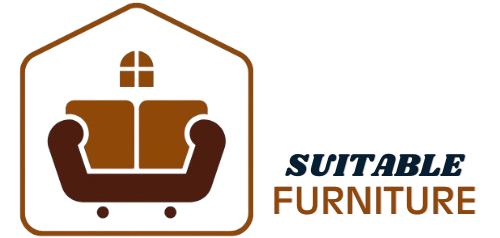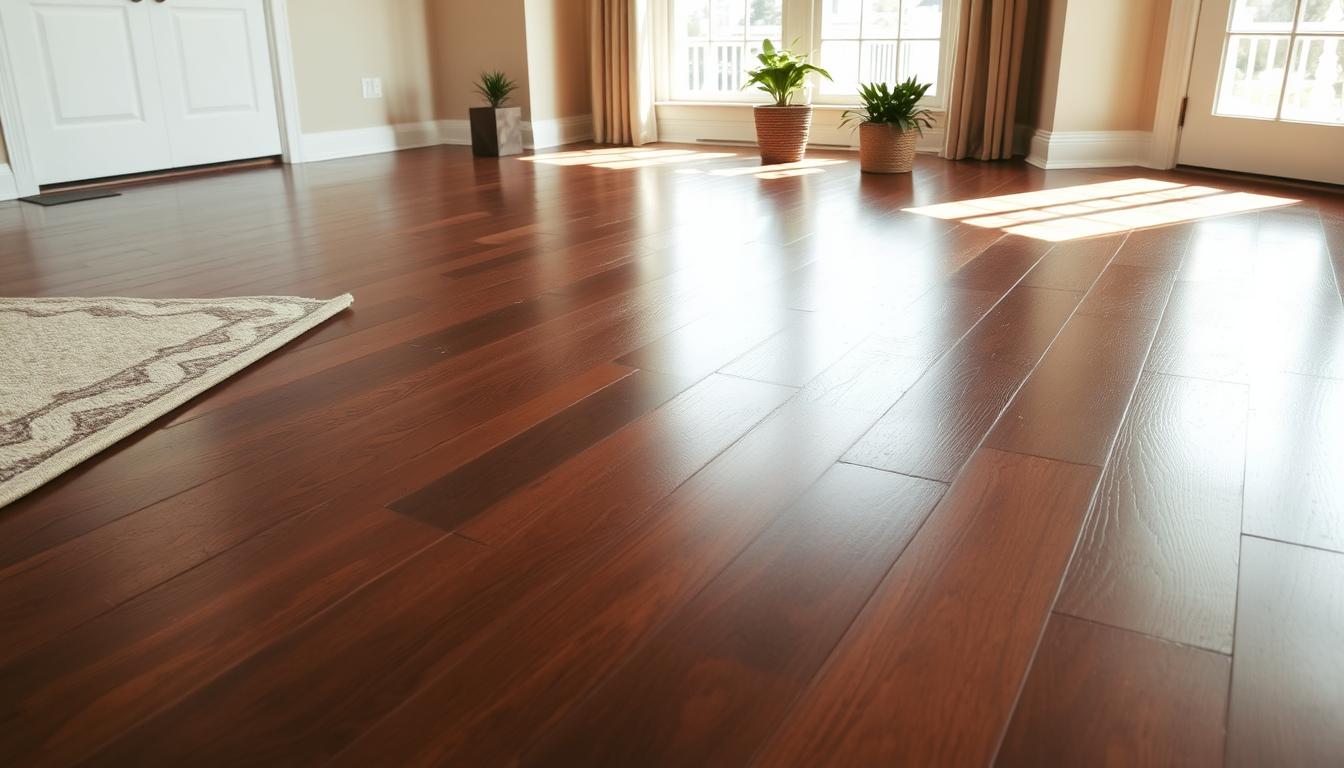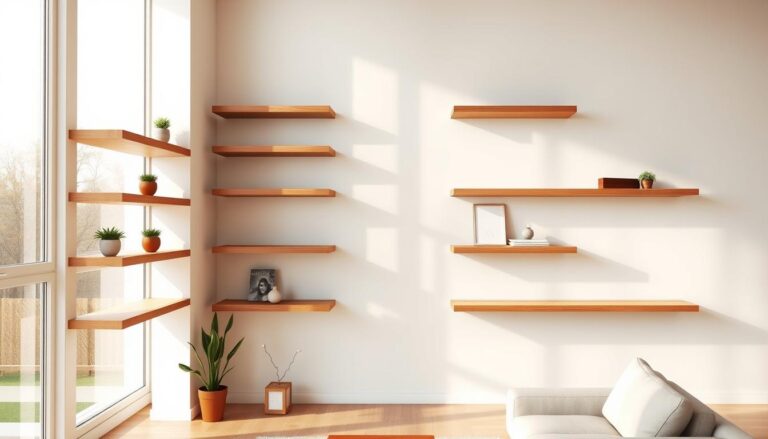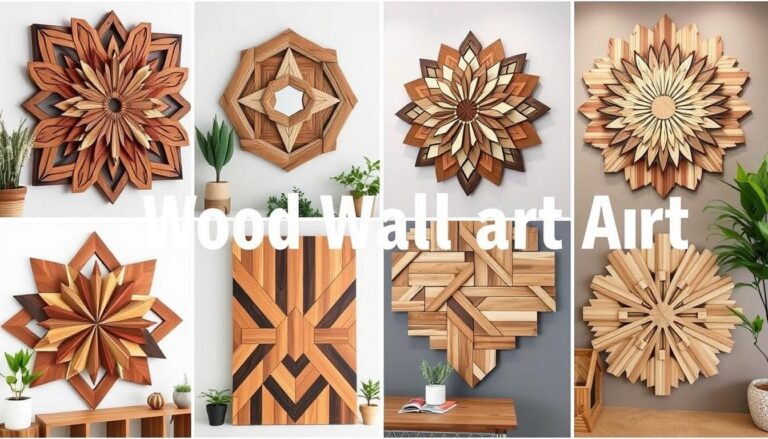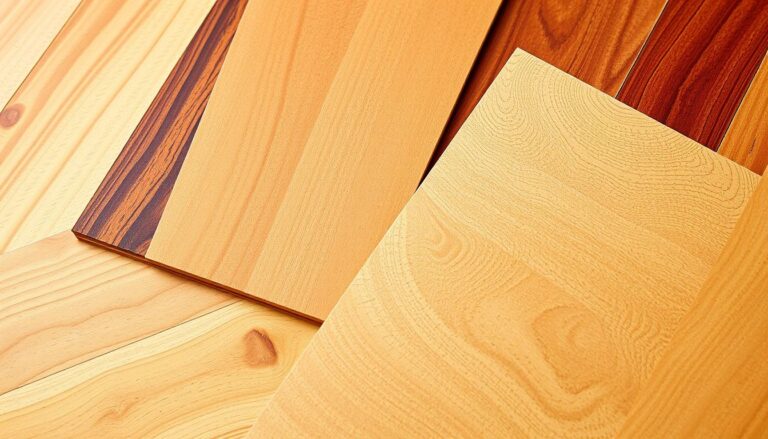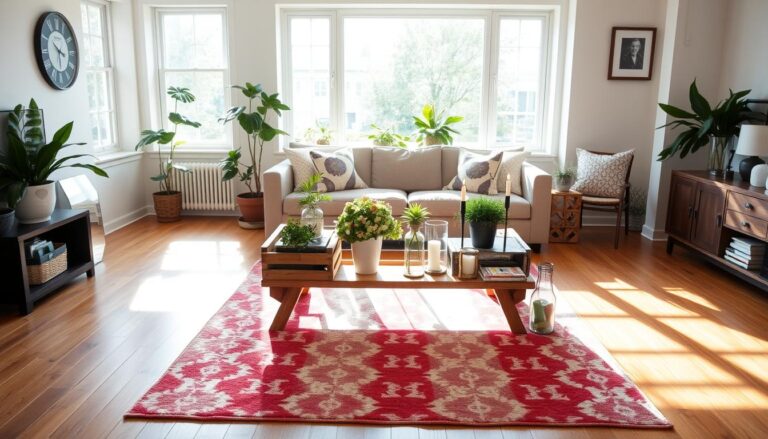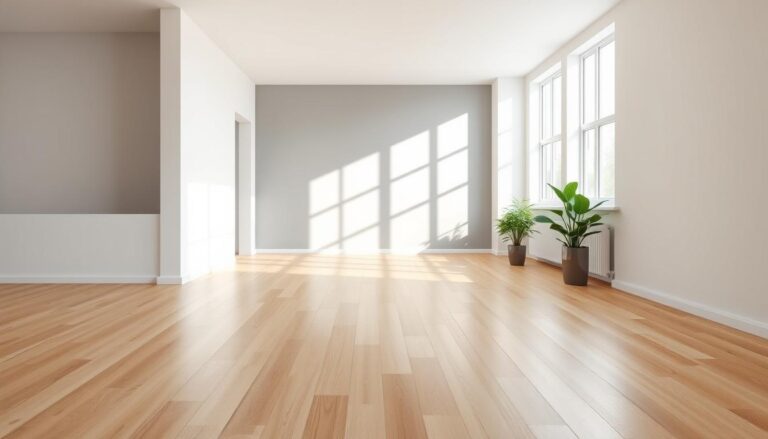How to Minimize Dust and Scratches on Dark Hardwood Floors
Dark hardwood floors bring a sleek look to homes. But, their smooth surfaces can show even small dust or scuffs. If your floors don’t stay clean, you’re not alone. Many struggle with this, but few understand why dark hardwoods need special care.
From tiny particles sticking to the finish to scratches that stand out, keeping dark hardwood floors clean is more than just sweeping. This guide uncovers the reasons behind their sensitivity. It also shares effective ways to keep them looking perfect.
Key Takeaways
- Dark hardwood floors need special cleaning to avoid damage to the finish.
- Scratches and dust are more noticeable because of light reflection and texture.
- Using simple tools like microfiber cloths and furniture pads can make a big difference.
- Keeping humidity in check prevents warping, which can hide imperfections.
- Professional refinishing can fix floors when daily care isn’t enough.
Understanding Why Dark Hardwood Floors Show Dust and Scratches
Dark hardwood floors, like walnut or ebony, make rooms look stunning. But, keeping them clean is tough because of their dark color. The contrast between the dark floors and light dust makes scratches and dirt stand out. This is a big point in discussions about dark hardwood floors.
Let’s look into why this happens and how to deal with it.
The Science Behind Visibility on Dark Surfaces
Dark wood floors absorb more light than light-colored ones. This means dust and scratches are more visible. When light hits these floors, particles like lint or pet hair reflect it unevenly. This makes them look more noticeable.
This contrast is why some people love dark floors for their look. But, it also makes them harder to keep clean.
How Light Reflection Impacts Appearance
Lighting can make surface flaws worse. For example, overhead lights can cast shadows that make scratches look worse. On the other hand, natural light can soften these imperfections.
Try different lighting setups to find the right balance. This will help you enjoy your dark floors while keeping them clean.
Common Types of Dark Hardwood Flooring
There are several popular dark wood flooring options:
- Walnut: Rich brown tones with deep grain patterns
- Charcoal oak: Stained to mimic sleek modern designs
- Teak: Naturally dark grain with oil-resistant properties
Each type has its own texture and finish. This affects how dust settles and scratches form. For instance, smooth ebony floors might show scratches more than textured walnut.
Benefits of Dark Hardwood Floors in Your Home
Dark hardwood floors bring timeless elegance to any room. Luxury dark hardwood flooring makes a bold statement, fitting well with both modern and rustic styles. These floors add depth, making rooms feel cozy and sophisticated without feeling too big.
They are very versatile. Best dark hardwood floors like walnut or reclaimed oak look great with light-colored furniture, creating beautiful contrasts. Their dark tones also hide dust better than lighter floors. Plus, they resist fading well under sunlight, keeping their shine longer.
- Elevates spaces with high-end aesthetics
- Enhances room proportions by visually expanding small areas
- Offers superior scratch resistance in high-traffic zones
Choosing quality options like solid hardwood or engineered planks means they last a long time. Homes with dark flooring can sell for 12-15% more than those with standard flooring. Dark tones also work well with both simple and bold styles, fitting easily with changing trends.
| Feature | Advantage |
|---|---|
| Color Retention | Resists fading from UV exposure |
| Style Flexibility | Suits contemporary or traditional aesthetics |
| Resale Impact | Increases property value by up to 15% |
For lasting beauty, pick best dark hardwood floors with durable finishes. Their timeless charm keeps your home stylish and functional for years.
Essential Prevention Strategies for Protecting Your Floors
Keeping your durable dark hardwood flooring in top shape is all about prevention. These steps help keep your floors looking great and working well. They’re all about taking care of your floors before problems start.
Strategic Furniture Placement
Move heavy items around every 6 months to stop sun damage and uneven wear. Use felt pads on furniture legs to avoid scratches. Keep heat sources like lamps away from your floors to prevent drying.
- Rotate furniture to spread sunlight evenly
- Anchor coasters under table legs to prevent dents
- Clear paths to avoid scuffs
Footwear Policies
Make a rule: no shoes inside. Encourage wearing indoor socks or soft slippers. Use doormats with deep pile to catch dirt before it hits the floor.
Pet Adaptations
Keep your pet’s nails short to avoid claw marks. Use carpet in busy areas. Teach pets not to jump on floors. Place washable rugs in pet zones.
Humidity Control
Keep humidity between 35-55% with a hygrometer. Use dehumidifiers in summer and humidifiers in winter. Keep potted plants away from floors to avoid moisture.
- Check humidity weekly during seasonal changes
- Avoid water bowls on wood surfaces
- Use fans to move air in closed spaces
Selecting the Right Protection Accessories
Protecting your high-quality dark hardwood flooring starts with smart accessory choices. These items act as the first line of defense against scratches and debris. They ensure your floors stay beautiful longer.
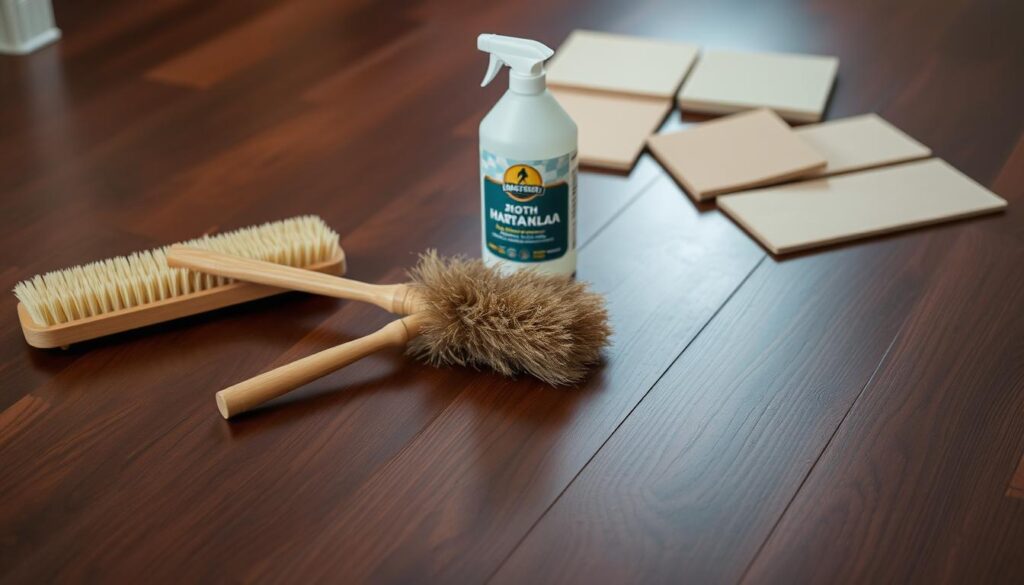
Quality Area Rugs and Runners
Choose area rugs with non-slip backing made from natural fibers like jute or wool. Brands like Mohawk Industries and Shaw Floors offer designs that stay in place without damaging finishes. Look for low-pile options in high-traffic zones to prevent dust accumulation.
Furniture Pads and Protectors
- Felt pads (e.g., FloorTrendz) for lightweight furniture
- Rubber or silicone bases for heavy items like dressers
- Replace pads annually to avoid cracked or worn materials
Always check compatibility with your dark hardwood floor care regimen. Avoid adhesive-backed options that can stain surfaces.
Entryway Solutions
Combat dirt and moisture with layered entry systems. Use a combination of:
- Coarse outdoor mats to trap gravel
- Indoor coir mats for moisture absorption (e.g., OXO Good Grips)
- Boot trays to collect debris before entering main living areas
Regularly shake out mats outdoors to maintain their cleaning efficiency.
Investing in these accessories ensures your floors retain their rich luster. Prioritize materials that work with your dark hardwood floor care routine while maintaining your space’s aesthetic.
Daily Cleaning Routines That Minimize Dust Buildup
Keeping dark hardwood floors clean is a daily task. Dust sticks to the wood grain, so cleaning often stops it from building up. This buildup can make scratches worse over time. Begin each day by sweeping or using a microfiber flat mop to get rid of loose dirt before it settles.
- Use a microfiber dusting cloth to gently wipe surfaces in the direction of the wood grain daily. Avoid dry dusters that scatter dust.
- Weekly, mop with a pH-neutral cleaner diluted in water. Wring mops thoroughly to prevent excess moisture damaging the wood.
- Place doormats at entries to trap dirt—replace them weekly to maintain effectiveness.
| Task | Frequency | Dark Hardwood Floor Care Tip |
|---|---|---|
| Dusting high surfaces | Every 2 days | Use electrostatic cloths to attract and trap fine particles |
| Vacuuming with hardwood attachment | Weekly | Focus on high-traffic zones like entryways and living areas |
| Spot cleaning spills | As needed | Blot immediately with a clean cloth—never scrub |
Use a zone system to clean faster. Focus on areas near windows and under furniture where dust builds up quickly. Microfiber dusting mitts, like those from Bona or Swiffer, catch 90% more dust than regular cloths. Clean when the sun is at its peak to see dust more clearly.
- Avoid feather dusters—they redistribute dust rather than removing it
- Rotate cleaning directions weekly to prevent pattern wear
Sticking to a daily routine is crucial. A 5-minute daily cleaning can prevent the need for harsh cleaning later. Also, check your floors monthly for deeper cleaning needs.
Choosing the Best Cleaning Tools for Dark Hardwood Floors
Keeping your dark hardwood floors in top shape needs the right tools. The right equipment helps keep your dark hardwood floor care routine effective. It also prevents damage to the surface.
Microfiber vs. Traditional Mops
Microfiber cloths and mops are better for dark hardwood floors than traditional string mops. Their electrostatic fibers catch dust and dirt without leaving streaks. Make sure to choose microfiber products that are labeled “non-abrasive” to avoid wearing off the finish.
Avoid mops with abrasive pads or stiff bristles. They can scratch the surface.
Vacuum Features That Won’t Damage Wood
- Rubber or felt wheels avoid scratching floors
- Adjustable height settings to prevent brush rolls from scraping floor surfaces
- Brush roll “off” mode for direct suction use
Look for vacuums like Bissell’s Hard Floor Vac or Dyson Animal+ that are safe for wood. Always check for “hardwood-safe” labels before buying.
Dust-Attracting Technologies
New tools like electrostatic dusters (e.g., Swiffer WetJet) and spray mops with microfiber pads are great for dusting. But, avoid steam mops unless they are specifically labeled safe for hardwood. Too much moisture can warp the wood.
Innovations like O-Cedar’s microfiber dusting shoes—worn over socks—let you dust hands-free. They won’t scratch the surface.
“Using the right tools is 70% of floor care. The other 30% is knowing when to avoid harsh methods.” – National Wood Flooring Association
Choose tools that are both effective and gentle. Look for durability and manufacturer warranties. This ensures your floors stay protected for a long time.
Recommended Cleaning Products That Won’t Dull Finish
Keeping your luxury dark hardwood floors in top shape is all about choosing the right cleaners. The right products help keep the color rich and the surface shiny. Stay away from cleaners that remove wax or damage the sealant to keep your floors looking fresh.
Begin with pH-neutral cleaners made for hardwood. Brands like Bona and Method have formulas that clean without harming the protective layer. Look for “pH 7” labels to make sure they’re balanced. These cleaners are perfect for daily use because they remove dirt without damaging finishes.
- Bona Hardwood Floor Cleaner – Combats scuff marks without residue
- Method Wood Floor Honeydew Mist – Scented option with no harmful chemicals
Natural options work great too. Mix ½ cup white vinegar with 1 gallon warm water for a streak-free shine. For light stains, try a 50/50 water and lemon juice mix. But avoid using undiluted vinegar, as it can damage wood over time.
Avoid cleaners labeled “oil-based” or “ammonia-containing.” Products like Murphy’s Oil Soap can leave residues that dull finishes. Bleach and abrasive powders can damage polyurethane coatings, causing permanent cloudiness. Never use steam mops, as the high heat can crack delicate finishes.
Always test new products on a small area first. Use microfiber mop heads with the right cleaners for the best results. Following these tips will help your luxury dark hardwood flooring stay beautiful for years to come.
DIY Scratch Repair Techniques for Dark Wood Flooring
Minor scratches on dark wood floors can be fixed with the right tools and methods. First, check how deep the scratch is. Shallow marks can be covered with color-matched solutions. But, deeper scratches might need sanding.
Always test any products on a hidden spot first. This helps avoid any bad results.
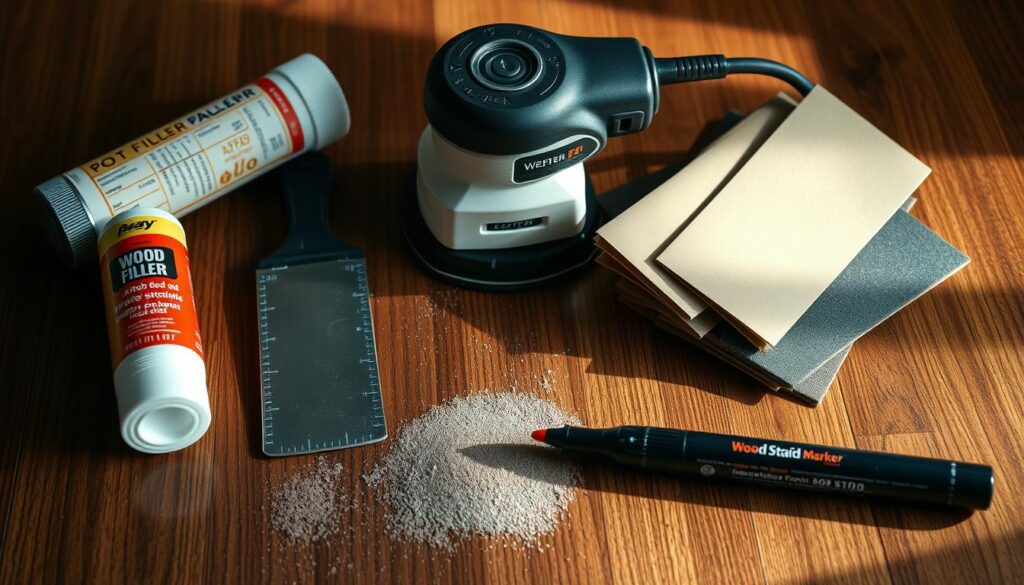
For dark hardwood floor care, stain pens or wax sticks work well for small imperfections. Brands like Minwax or Woodcraft have wood tone markers that match your floor. Apply the pen in the grain direction and buff off extra with a soft cloth.
For deeper scratches, you might need to sand lightly first. Then, apply stain that matches your floor’s color. Use samples from suppliers like Armstrong or Teragren to get the right shade.
- Surface scratches: Use color-matched stain pens (e.g., Minwax Wood Finisher).
- Deeper marks: Sand lightly with 220-grit paper, then apply stain and polyurethane.
- Always wear gloves and work in well-ventilated areas to prevent skin contact or fumes.
A basic repair kit should have: microfiber cloths, sandpaper, stain samples, and a small foam brush. Don’t soak the wood too much, as it can warp. DIY fixes can make your floor look better, but big damage might need a pro.
Keep your floor in good shape by sweeping daily and using protective pads under furniture legs.
When to Call Professionals for Hardwood Floor Maintenance
Knowing when to seek professional help is key to keeping your dark hardwood floors looking great. Ignoring big problems like deep scratches or water damage can cost a lot to fix later. Here’s how to know when it’s time to call in the experts.
Signs Your Floors Need Expert Attention
- Visible cracks or warping across large areas
- Peeling finish exposing bare wood
- Standing water stains or buckling boards
- Uneven surfaces from improper dark hardwood floor installation
Services That Add Long-Term Value
Professionals do more than just clean your floors. They also:
- Restore floors from top dark hardwood floor brands
- Reapply protective finishes
- Fix installation mistakes
- Offer custom solutions for busy areas
Questions to Ask Pros Before Hiring
Ask contractors:
- “Do you work with top dark hardwood floor brands?”
- “Can you show me examples of similar repairs?”
- “What kind of guarantees do you offer for installation?”
Good experts will tell you the cost upfront. It usually ranges from $200-$500 per hour, based on the service and brand.
Refinishing Options to Restore Dark Hardwood Floors
Dark hardwood floors can look new again if they have scratches or faded finishes. You don’t need to spend on dark hardwood floor installation to do this. First, check if your floor can be sanded by measuring its wear layer. Most floors today have enough finish for a good sanding.
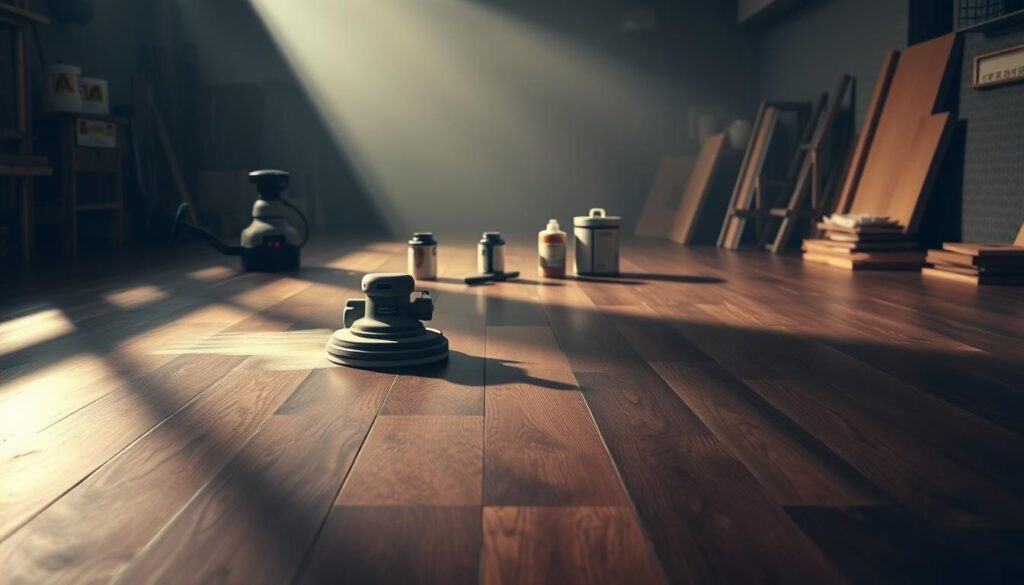
There are three ways to refinish your floors: screen-and-recoat for small issues, full sanding for deeper problems, and full restoration for really old floors. Water-based polyurethane dries fast and looks clear. Oil-based finishes go deeper into the wood. Hybrid options mix both, being tough and good for the planet.
“A well-executed refinishing job can extend a floor’s lifespan by 15-20 years,” says the National Wood Flooring Association. “It’s often half the cost of replacement.”
- Water-based polyurethane: Dries in 2-4 hours, reduces VOCs
- Oil-based finishes: Enhances wood grain, takes 24 hours to cure
- Hybrid systems: Eco-friendly yet tough, suitable for high-traffic areas
The refinishing process takes 2-3 days and might disrupt your home. It costs $3–$7 per square foot, much less than installing new floors. To keep your floors looking great, mop them monthly and have a pro check them every year. With the right care, your floors will stay beautiful for many years.
Seasonal Care Tips for Different Climate Conditions
Seasons bring unique challenges to your dark hardwood floors. From winter’s dry air to summer’s humidity, adjusting your dark hardwood floor care routines ensures lasting beauty. This section outlines steps to protect your investment year-round.
Winter Protection Strategies
Cold weather risks include cracked wood from heating vents and salt damage. Key steps:
- Use salt-free de-icers outdoors to prevent residue from entering.
- Place absorbent mats at all entries to trap moisture and grit.
- Set humidifiers to 30–50% humidity to avoid drying out wood fibers.
Summer Humidity Management
High humidity warps wood and fades finishes. Try these tips:
- Keep windows closed during rainstorms to block moisture.
- Use UV-protective window films to reduce sun exposure.
- Run dehumidifiers in damp areas like basements connected to main floors.
Even waterproof dark hardwood flooring needs shade—direct sunlight causes fading over time.
Spring and Fall Maintenance Schedules
These transition seasons require proactive steps:
- Spring: Deep-clean with pH-neutral cleaners and inspect for hidden scratches.
- Fall: Check door seals to block drafts and reapply protective coatings.
Regular inspections during these months prevent damage before harsh weather hits.
Modern Innovations in Dark Hardwood Floor Technology
Today’s dark hardwood floors use new materials and methods. They make floors last longer and are better for the planet. New finishes and ways to make floors help avoid scratches and protect the environment.
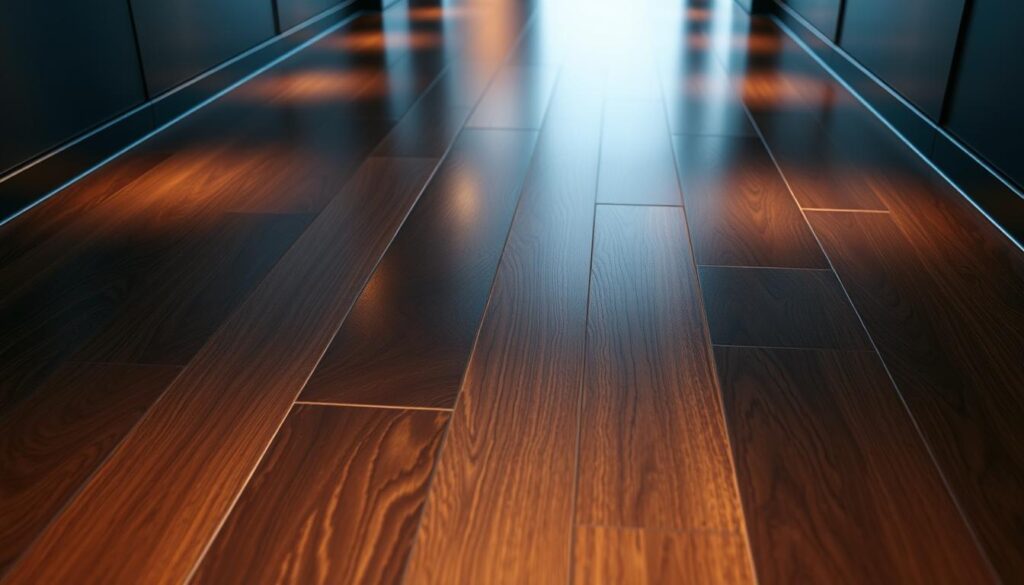
- Ceramic-infused urethane coatings repel dirt and resist wear for long-lasting protection.
- UV-cured finishes cure instantly under light, forming a hard, dust-resistant layer.
- Smart humidity sensors now integrate with home systems to protect against moisture damage.
Eco-friendly dark hardwood flooring is getting better too. Brands like Armstrong and Teragren are leading the way. They offer:
| Type | Features | Benefits |
|---|---|---|
| Reclaimed Wood | Recycled materials, FSC-certified sourcing | Reduces waste while maintaining rich dark tones |
| Water-Based Urethane | Low VOCs, biodegradable ingredients | Safer for indoor air quality |
| Bamboo Composites | Blends bamboo with hardwood for strength | Renewable resource with a classic dark wood look |
These new developments mean you can have dark wood floors without harming the environment. Look for brands like EcoTimber or Bruce Hardwood. They offer floors that are both stylish and eco-friendly.
Conclusion: Maintaining Beautiful Dark Hardwood Floors for Years to Come
Dark hardwood floors bring timeless elegance to any room. But, they need consistent care to stay beautiful. Start with simple steps like using furniture pads and microfiber cloths for cleaning.
Many think cheap dark hardwood flooring needs more effort. But, it’s not true. Even affordable options last longer with pH-neutral cleaners and regular checks. Avoid dragging furniture and keep humidity in check to prevent warping.
Regular checks and small repairs can prevent big problems. Seasonal changes, like using area rugs in winter, help them last longer. When refinishing is needed, hire pros for a perfect finish.
Dark hardwood floors are a lasting style choice for your home. Following proven care methods keeps them looking great and increases resale value. Their sleek look remains popular, making them a wise choice for those who value both beauty and durability.
